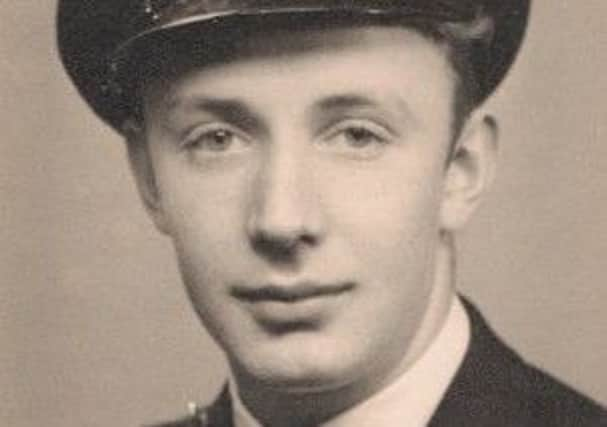Obituary: John Fairful Cunningham, Atlantic Convoy veteran


An ill-conceived attempt to safeguard one of his possessions almost proved fatal for John Cunningham and threatened to end his war at the age of just 16. For the young sailor defied the consequences of a torpedo attack on his vessel to go back to his cabin to retrieve his watch and ended up alone, the last man standing on the deck of the sinking ship.
The merchant vessel, the Trefusis, was part of the Atlantic Convoy XK-2 that had already been harried and bombed by German Focke-Wulf 200 aircraft – a plane Churchill described as the “scourge of the Atlantic” – after leaving Gibraltar.
Advertisement
Hide AdAdvertisement
Hide AdBut as she approached the Bay of Biscay, she fell prey to a German U-boat’s underwater missile. The engine room took a direct hit. Despite the deafening explosion Cunningham made the decision to return to his accommodation but by the time he got back on deck all the lifeboats were in the water. A ship to their starboard had been crippled and sank like a stone with the loss of all but three hands. Another two vessels had also been hit.
Amid the mayhem the teenager had no option but to hurl himself overboard into the sea. Although three colleagues perished in the attack, he was rescued by his crewmates and hauled into the lifeboat.
Along with the remaining 43 survivors from the Trefusis he was picked up by an escort vessel and returned safely to Britain. Fortunately, he had fared better than his timepiece: the watch that he had risked everything to retrieve turned out to be completely useless.
After just a couple of weeks’ home leave in Edinburgh he was back into the fray of the conflict at sea, contributing to campaigns including the invasion of Sicily and travelling the world from the Mediterranean to Uruguay and India.
Still only 19 when the Second World War ended, he went on to pursue a vastly different career on dry land, becoming a bank manager and later working for the Commonwealth Institute until he was 70.
Born in Edinburgh’s Morningside, he later lived in Ellersley Road, where his father was chauffeur to the Crawford family, and was educated at Roseburn Primary and George Heriot’s. Leaving school at 15 he fulfilled a long-held ambition to complete a Merchant Navy Cadet course at Leith Nautical College and in August 1942 signed up with the Hain Steam Company.
His first ship was the SS Trefusis, which joined the Atlantic Convoy at Loch Ewe and sailed to America with 30 other vessels to load up with phosphates. His next, rather more eventful Atlantic convoy, XK-2, was heading for Freetown in Sierra Leone, to collect iron ore, when it was hit by a hurricane, encountering waves twice the height of houses. It was after leaving Gibraltar, on the return journey, that the convoy was torpedoed, at 5:45pm on 5 March, 1943. Young Cunningham was the last man off before the Trefusis sank within 30 minutes of the attack. About 90 survivors from the convoy spent the following seven days aboard the converted trawler escort that rescued them before landing at Londonderry.
His next ship was the SS Empire Cato, by this time under the control of the army for use in beachhead landings. Loaded with troops of the 1st Canadian Division for the invasion of Sicily, the convoy set sail from the Clyde. After passing through the Straits of Gibraltar, three ships were sunk by torpedoes but this time everyone on board survived and, after another large contingent joined the convoy, the invasion of Sicily began.
Advertisement
Hide AdAdvertisement
Hide AdAfter discharging the troops and equipment they headed back to Algiers, where a neighbouring ship caught fire and exploded at sea with the loss of hundreds of soldiers. From there, loaded up with petrol and shells, it was on to Phillipsville to collect 1st Army troops bound for Salerno – and another encounter with the enemy. “As we entered Salerno bay the Royal Navy destroyer escorts wished us good luck. And did we need it!” he recalled. “We were at anchor getting shelled and dive-bombed at night. How we got missed I’ll never know. Our barrage of anti-aircraft fire was pretty powerful.”
From there he sailed across the South Atlantic to Uruguay and Argentina, returning to Glasgow via North Africa before joining the Empire General, loaded with shells, bailey bridges and petrol, bound for Ancona, on the Italian Adriatic, where they dodged German E-boats.
His next voyage, to take supplies to RAF base in Chittagong, India, was his most traumatic as the Japanese took them by surprise, dropping anti-personnel bombs while the vulnerable merchant vessel had no RAF cover in the skies above.
“This attack upset me more than other actions as it was so unexpected.”
His final mission was to take Royal Marines to Port Dickson in Malaysia but before they saw any action the atomic bombs were dropped on Hiroshima and Nagasaki and the Japanese surrendered, signalling the end of the war in the Far East.
He left the Merchant Navy in 1947 and joined the Bank of Scotland, sitting his banking exams and later working on relief duty in various different branches before being based at Penicuik and then at Piershill in Edinburgh, as the manager, where he stayed until retiring. His subsequent job with the Commonwealth Institute in Edinburgh was, he said, the best job he ever had.
Latterly his decreasing mobility left him housebound at home in Corstorphine but an annual pleasure was watching the flypast of military aircraft from the Edinburgh Tattoo. Fittingly, his own four war medals are held in Edinburgh Castle. Predeceased by his wife Ada, whom he married in 1953, he is survived by their children Fiona, Peter and Andrew and extended family.